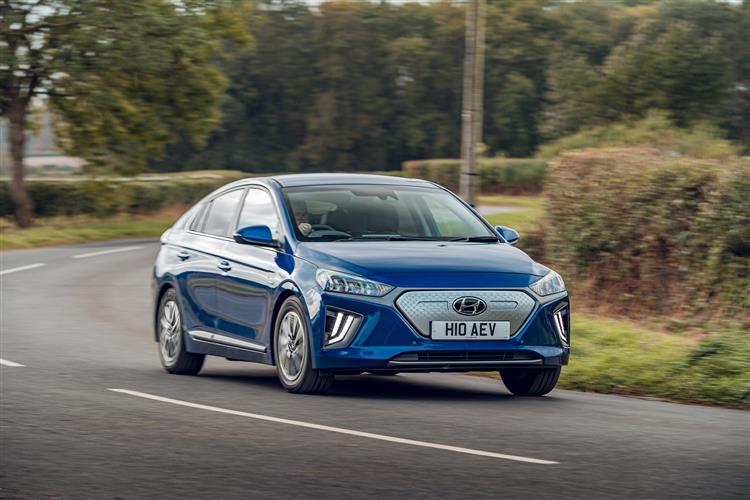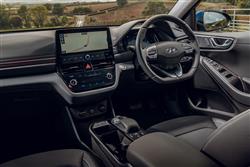HYUNDAI'S EARLY SPARK (some text hidden) --NONE--
By Jonathan Crouch
Introductionword count: 101
Back in 2016, Hyundai believed that the market-leading Nissan LEAF had had its own way for far too long in the affordable part of the slowly growing full-electric car segment. They aimed this full-Electric IONIQ model directly at that car and it subsequently also served the brand against a newer wave of EVs like the Volkswagen ID.3. On paper at least, this IONIQ Electric certainly seems to offer a package that eco-minded buyers in this class looking for EV models from the 2016 to 2022 period will want to consider, particularly in the upgraded longer-range version that was introduced in 2019.
Modelsword count: 4
5dr family hatch (EV)
Historyword count: 386
Once upon a time, Hyundai built simple, cheap, budget brand cars. But by 2016, it was making models like the IONIQ, which was the world's first vehicle to offer the choice of three electrified powertrains. We're looking here at the IONIQ Electric. It was the full-battery-powered version of a design that was also available in our market with Hybrid and Plug-in Hybrid power - and it was very advanced for its time. The IONIQ Electric was originally launched just after the Hybrid versions, back in 2016, initially with a 28kWh battery mated to an 88kW electric motor. But that only allowed for a driving range of 124 miles and as EV technology progressed towards the end of the 21st century's second decade, it was soon clear that this wasn't going to be enough to keep this battery-powered IONIQ fully competitive. So in mid-2019, Hyundai significantly upgraded the engineering of this car, adding in a bigger 38.3kWh battery mated to a more powerful 100kW electric motor which together increased the EV driving range by nearly 60%. At the same time, the car got an infotainment upgrade with the introduction of a sophisticated new 10.25-inch widescreen navigation system with sophisticated smartphone app-based Bluelink telematics. During this period, much the same powertrain also featured in another of Hyundai's models, the Kona Electric, but in that car, it was linked to a much larger 64kWh battery which took you a lot further on a single charge than this IONIQ Electric could go. The Kona Electric was significantly pricier though and if all you actually need is a level of battery charge that will cover you for short-to-mid-run urban and commuting mileage, then what this IONIQ Electric's smaller battery can offer might well be quite sufficient for your needs. In Hybrid and PHEV Plug-in hybrid forms, the IONIQ went head-to-head with the car it was primary launched against, the Toyota Prius but in this full-electric form, it set itself apart with an extra full-battery-powered option at an affordable price. Like its combustion stablemates, the IONIQ Electric sold until 2022 when it was a effectively replaced by a new wave of Hyundai full-Battery models like the IONIQ 5 and the second generation Kona Electric. So does this earlier Hyundai stab at EV motoring make sense as a used buy? Let's find out.
What You Getword count: 516
This Hyundai challenged the eco-motoring status quo in lots of ways and exterior design was another of them. On this battery-powered full-Electric variant, a front grille wasn't of course needed - not for cooling anyway. We'd argue that it is required for stylistic reasons, a point proved by the way that this battery-powered version was saddled with a rather ugly blanking panel that could be ordered in a choice of grey shades or in polar white. Inside, Hyundai took much the same conventionally futuristic approach. You know you're in something more advanced than an ordinary Focus or Golf-class family hatch from the 2016-2022 period, but there's nothing here that'd be too taxing to adjust to. Well almost nothing anyway. The IONIQ Electric of course had to differ from its Hybrid and PHEV showroom stablemates when it came to the provision of a gearstick because of course it didn't need to have one. Instead, on the separated lower centre console between the seats, the single-speed transmission system offers small buttons for 'Park', 'Neutral', 'Drive' or 'Reverse'. The cabin of the revised updated post-2019 model feels of higher quality than the original version launched in 2016 - and is certainly a little smarter than what you get in a comparable Prius or a Nissan LEAF. The big change made as part of the mid-term update lay with the addition of a big 10.25-inch Widescreen Navigation screen, part of a media package which included a very decent Infinity sound system, Apple CarPlay/Android Auto smartphone-mirroring and a suite of the brand's Bluelink connected telematics car services, these operating via a connected app. Anything this central monitor can't tell you will probably be covered off by the 7-inch 'Driver's Supervision Cluster' screen which replaces conventional gauges in the instrument binnacle. Here, a circular display with a digital speedo is flanked by Power/Charge meter on the left and a battery indicator on the right. Taking a seat in the rear is a process that, unless you're really quite short, will involve the need for a slight incline of your head below the sloping roofline. Having done that, you might not be too surprised to find that once inside, as in, say, a Toyota Prius, headroom is at something of a premium for taller folk. Normally, the rear seats would have been positioned a little lower to compensate for the swept-back ceiling, but that's not possible in this case since they sit right on top of the powertrain's battery pack. Finally, let's consider the boot space on offer. A lot of the early battery-powered cars designed in this period managed to package in their batteries without encroaching on luggage room but that's not the case here. The 443-litre capacity you get in an IONIQ Hybrid falls to 350-litres here - that's 55-litres less than a Nissan LEAF. If you load this IONIQ to the roof, the figure rises to 455-litres. When you push the 60:40 split-folding rear bench forward, it doesn't free up a completely flat loading area but you do get as much space as likely buyers will need, 1,410-litres being provided.
To see the full road test text contact us on 0330 0020 227
Pictures (high res disabled)

.jpg)
|
.jpg)
|
.jpg)
| |||
.jpg)
|
.jpg)
|
.jpg)
| |||

|
Scoring (subset of scores)
Category: Hybrid, Plug-in, Electric & Hydrogen
| Performance | |
| Handling | |
| Comfort | |
| Space | |
| Styling, Build, Value, Equipment, Depreciation, Handling, Insurance and Total scores are available with our full data feed. | |



